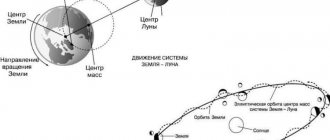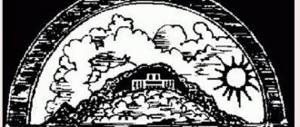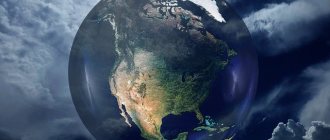What is the Moon?
The Moon (means light) is the cosmic body of natural origin closest to Earth.
The planet's closest satellite to the Sun, since the planets closest to the Sun, Mercury and Venus, do not have satellites. The second brightest object in the earth's sky after the Sun and the fifth largest natural satellite of a planet in the solar system. The average distance between the centers of the Earth and the Moon is 384,467 km. Let's find out how long it would take us to get to the Moon if this journey could be made using different types of transport. On a rocket – 2-3 days. By plane - 3 weeks. By train or car for more than six months. And on foot - 50 years.
The diameter of the Moon is four times smaller than that of the Earth, and its mass is 81 times less than the mass of our planet. The moon shines not with its own light, but with reflected sunlight. On the Moon, a day lasts 14 Earth days, and a night lasts 14 nights. The temperature changes sharply during the day, plus 150 degrees, and at night, minus 150 degrees.
The Moon is the only extraterrestrial astronomical object visited by humans.
There are many hypotheses about the origin of the Moon. The main hypothesis is currently considered to be the theory put forward in 1984 at the Hawaiian Conference on Planetary Science, called the Giant Impact theory. The theory states that the Moon appeared 4.6 billion years ago after the collision of the Earth with a hypothetical celestial body called Theia. The blow did not land in the center, but at an angle (almost tangentially).
As a result, most of the substance of the impacted object and part of the substance of the earth's mantle were thrown into low-Earth orbit. From these fragments the proto-Moon was assembled and began to orbit with a radius of about 60,000 km (now ~ 384 thousand km). As a result of the impact, the Earth received a sharp increase in rotation speed (one revolution in 5 hours) and a noticeable tilt of the rotation axis. Before this there was no life on Earth.
The appearance of the Moon can be seen in experiment 1, using water and vegetable oil (Fig. 1) I poured water into a glass and added vegetable oil. Then he stirred the oil with a spoon and took it out. As a result, it was clear that the oil bubbles, similar to fragments of the Earth, were combined into one whole. This is how the Moon was formed.
Fig. 1 Photo The emergence of the Moon
Moon Mountains
But there are mountains on the Moon, and the most real ones, and not only mountains, but also plateaus. Externally, they differ from the lunar “seas” and plains in that they are lighter in color.
The lunar mountains are similar to the terrestrial ones in appearance, but unlike them, they were formed not as a result of tectonic processes, but as a result of collisions of giant meteorites with the lunar surface.
What would the surface of the Moon look like if it had an atmosphere and gravitational force similar to Earth's (sweep)
Structure of the Moon
The Moon moves in an elliptical orbit and consists of a crust, an upper mantle (asthenosphere), a middle mantle, a lower mantle and a core.
Fig.2
The Moon - the shell of the inner core is rich in iron, it has a radius of 240 km, the liquid outer core consists mainly of liquid iron with a radius of approximately 300-330 kilometers. Around the core there is a partially molten boundary layer with a radius of about 480-500 kilometers.
There is practically no atmosphere. The surface of the Moon is covered with regolith, a mixture of fine dust and rocky debris formed as a result of meteorite collisions with the lunar surface. Regoliths contain iron and volatile components, such as silicon dioxide. Impact-explosive processes accompanying meteorite bombardment contribute to loosening and mixing of soil, while simultaneously sintering and compacting soil particles.
There is almost no water (most recently ice blocks were found at the bottom of the northern craters), and the surface is almost completely dotted with craters and large flat areas are also called lunar seas. There are up to 30 seas. The dark areas of the moon - the seas - can be seen with the naked eye.
Z - “lunar hare”, A - Tycho crater, B - Copernicus crater, C - Kepler crater, 1 - Ocean of Storms, 2 - Sea of Rains, 3 - Sea of Tranquility, 4 - Sea of Clarity, 5 - Sea of Clouds, 6 - Sea Abundance, 7 - Sea of Crises, 8 - Sea of Humidity
Depressions in the surface of the Moon are called craters. Many years ago, the scientist Galileo Galilei called them seas. Now we already know that there are no seas on the Moon, but according to tradition, the craters have retained their names. Many of them have unusual ones for the Earth - the Sea of Abundance, the Sea of Cold, the Sea of Rain, the Sea of Clarity, the Sea of Vapor. Smaller craters bear the names of famous people - Tycho Brahe, Copernicus, Ptolemy, Yuri Gagarin.
The hills on the surface are called the Moon Mountains. Their names are quite Earthly - Caucasus, Altai, Carpathians, Alps, Apennines, Perinees, Tenerife. The height of the mountains can reach up to eight kilometers, but usually they reach 3-5 km.
Today, craters no longer form on the Moon. But many years ago, according to scientists, it happened like this: first, a meteorite approached the surface of the Moon, then it crashed into the surface at high speed and a lot of dust was formed. When the dust settled, it became clear that due to the collision of the meteorite with the Moon, a dent had formed, and in its center there was a hill. At that time, there were still volcanoes and eruptions on the Moon, lava filled the craters and they became less deep.
The presence of caves on the moon has also been discovered.
The appearance of craters on the Moon can be seen in experiment 2 , using a ball (Fig. 2). If you throw a ball into the sand from a certain height, you can observe depressions that remain after the ball falls, similar to craters.
Cratering on the Moon
Questions and answers:
Why does the moon glow? — Its surface does not glow on its own; it reflects the sun’s rays like a mirror.
Why is the unlit part of the Moon sometimes faintly visible? “At such moments, it is illuminated by the Sun, the light of which is reflected by the Earth itself. This phenomenon is also called the “ash light” of the Moon.
Ash Moonlight
Which side of the Moon is considered dark? — The one that is not illuminated by the Sun at the time of observation.
Are there volcanoes on the Moon? - Yes, only a few pieces. But they are either too low to stand out seriously, or too small to be considered more important than ordinary hills.
Why are there so many craters on the Moon? — Collisions with asteroids, comets and other cosmic bodies leave deep craters, like after explosions. They are called craters. The Moon has neither an atmosphere to protect it from meteorites, nor water or wind that could smooth out collision sites. Therefore, it is not strange that over the 4 billion years of the Moon’s life, so many craters have accumulated on it.
Placer craters on the Moon
Is there lava on the moon? — There is no fresh, hot and red lava on the surface of the Moon. But there is a cooled one - for example, in the lunar seas.
Why are there so many different faces in the craters on the map? — Inside some craters there are depicted the faces of those famous people whose names they bear. Others are simply drawn
Others are simply drawn
Apollo 17 on the Moon
What do the red icons with numbers mean on the map? — They show the landing sites of spaceships on the Moon. The numbers abbreviate the names - the decryption key is located in the lower right part of the card.
What do the multi-colored dots mean? “They point to the places where space probes landed on the Moon (or where they crashed).
What do the rings on the moon mean? “They mark the rims of the craters.
Where do the light and dark spots on the Moon come from? “The dark zones of our satellite are “young” areas covered with solidified lava. Their age ranges around 3 billion years. The lighter areas are older - these are the crater-strewn highlands that were mentioned at the beginning. Their age is 4 billion years.
Why is the Moon gray? - In fact, the surface of the Moon is black as coal. It is caused by the strong light of the Sun to glow bright gray.
Footprint of Neil Armstrong, the first man to walk on the moon in 1969.
Have there been people on the moon? “So far, it remains the only cosmic body outside the Earth on which man has set foot. In total, 12 astronauts visited there - all Americans. 11 of them were jet fighter pilots trained for space flights. Another astronaut was a geologist. The remaining astronauts work either in lunar orbit or in near-Earth space, and have not yet been to extraterrestrial worlds.
Moon phases
The moon revolves around our planet in 27-28 days. During approximately the same time, the Moon rotates completely around its axis, so we only see one side of the Moon (photos of its far side are taken only from space).
If you carefully observe the Moon for a month, you will notice that the Moon is always visible in different ways - sometimes a thin sickle, sometimes a round pancake. Sometimes its ends are directed in one direction, and sometimes in the other. These changes are called phases of the moon.
The Moon goes through the following phases of illumination: new moon - a state when the Moon is not visible (state 1 in the figure); neomenia - the first appearance of the Moon in the sky after the new moon in the form of a narrow crescent; the first quarter is the state when half of the moon is illuminated (state 3 in the figure);
full moon - a state when the entire Moon is illuminated (state 5 in the figure);
the last quarter is the state when half of the moon is illuminated again (state 7 in the figure).
To distinguish the first quarter from the last, located in the northern hemisphere, you can use the following rules. If the lunar crescent in the sky looks like the letter “C”, then this is the “Aging” moon, that is, this is the last quarter. If it is turned in the opposite direction, then by mentally placing a wand on it, you can get the letter “R” - the moon is “Waxing”, that is, this is the first quarter.
The waxing month is usually observed in the evening, and the aging month in the morning.
It should be noted that near the equator the month is always visible “lying on its side”, and this method is not suitable for determining the phase, and in the southern hemisphere the phases of the moon occur in the reverse order.
To illustrate the phases of the moon, we will perform a simple experiment 3 . Let's take a big ball and imagine that it is the Moon. Let's turn off the light in the room and, using a flashlight, which plays the role of the Sun, we will try to see all the phases of the moon one by one.
Moon phases
Observing the phases of the moon in September 2020
Lunar eclipses
Sometimes we can observe a phenomenon called
a lunar eclipse . It occurs when the Sun, Earth and Moon are on the same line and the Earth covers the Moon from the Sun with its shadow. An eclipse can be not only total, but also partial. In this case, the shadow of the Earth does not fall on the entire Moon, but only on a piece of it. A lunar eclipse can last up to one hour.
The last lunar eclipse occurred on January 21, 2020 (total).
I was able to observe a partial lunar eclipse from July 16 to July 17, 2020, which lasted about 2 hours.
Ebbs and flows
At first the Moon was much closer to the Earth than it is now. And this was 4-5 billion years ago. Now it is located at a distance of about 400 thousand kilometers, and then the distance was equal to two diameters of the Earth, and therefore it had a very strong impact on the Earth and the origin of life.
From the impact, the Earth tilted from its axis by 23 degrees, and it was this tilt that made it possible to create 4 seasons on Earth - winter, summer, spring, autumn. Before the impact, the Earth rotated around its axis in 6 hours. The moon gradually increased its rotation to 24 hours. The proximity of the moon raised gigantic waves several kilometers high from the oceans. Gradually, the Earth and the Moon are moving away from each other by 3.8 cm per year. And so, over billions of years, these giant waves and tides slowly subsided, and life appeared on our planet.
When giant tsunamis are shown on TV, I can imagine what even larger waves were raging every minute back then. The Earth and the Moon are held together by gravitational forces on the surface of the Earth facing the Moon, these forces add up. This does not affect the land, but ocean waters rise on both sides of the planet.
Due to the rotation of the earth, the waves move, and there are two high and low tides per day. When the Sun, Moon and Earth are on the same line, their gravitational forces add up ( Gravity is the universal fundamental interaction between all material bodies). This is how the strongest tides arise.
Facts about the Moon:
- The oldest mountains on the Moon are considered to be its highlands. Their age exceeds 4 billion years! These hills are densely dotted with meteorite craters - so dense that you can barely find a piece of surface free from them. New impact craters are stacked on top of each other, erasing the boundaries of old craters.
- All the irregularities on the satellite, from huge depressions to the smallest craters, are the consequences of collisions with asteroids and space debris. They fall on the Moon as often as on Earth. But our satellite is not protected by an atmosphere in which most meteorites simply burn up - and when only 128 craters were found on Earth, on the Moon their number exceeded 15 thousand.
- The lunar "seas" are actually ancient plains of solidified lava. They were formed at the sites where the largest asteroids fell. Their mass generated explosions that were hundreds of times more powerful than the most powerful nuclear bomb. The impact craters were so large and deep that lava seeped to the surface and spread out into a lake.
- There are no rocks, large boulders or pronounced rocks on the Moon, like on Earth. Being exposed to the destructive influence of the Sun and outer space for billions of years, they dissipated into rock powder - the famous lunar dust that covers the entire satellite.
- Despite these destructive processes, the appearance of our satellite is changing very slowly. Dinosaurs who lived millions of years ago saw the Moon in the sky the same way we see it now. While the continents on the planet were transforming, taking on their current shapes, the surface of our satellite remained almost unchanged.
- The youngest formations on the Moon are craters with light rays. There are no visible traces of water on the surface of our planet’s satellite. Even the winding channels on the Moon, similar to river beds, were formed from volcanic lava flows.
The influence of the Moon on a person
The influence of the moon is undeniable. Of course, our native planet Earth has the greatest influence on humans, but the influence of other planets cannot be excluded. Nowadays, no one doubts that solar processes affect the human body. At the same time, the influence of the Moon is unfairly called into question. But the Moon, although much smaller than the Sun, is much closer to the Earth. The mass-distance relationship indicates a slightly greater influence of the Moon on objects on Earth.
Scientists have long noticed that the ebb and flow of tides is controlled by the Moon. Lunar gravity causes the ocean level to rise by 1.5 meters, and in narrow bays this value reaches 12-16 meters. Even the solid shell of the Earth reacts to the movement of the Moon - it rises by 50 centimeters (this rise occurs quite evenly, so we do not notice it). Therefore, it is not surprising that the human body, consisting of 80% liquid, is subject to lunar influence. In addition, the Moon also affects the Earth’s magnetic field, and we have all heard about the danger of magnetic storms.
How do we feel when the Moon is waxing and when it is waning?
On the waxing moon, a person feels a surge of strength, optimism, readiness to cope with any task and confidence in his abilities. On the contrary, in a decreasing period there is a loss of strength, weakness, a desire to give up everything. At this time, the greatest number of requests from people in a depressed state is observed.
In this regard, any projects should be started on the waxing moon, and completed on the waning moon. This, of course, does not mean that you need to complete your project within the same lunar month. It is simply advisable to take this point into account and break your projects into stages, which should be adjusted to the lunar calendar.
In accordance with this, on the waxing moon it is worth starting health courses related to strengthening the body, moisturizing the skin - in general, any procedures related to absorbing new things. Whereas on the waning moon you need to get rid of everything that is no longer needed: various cleansings are carried out (skin, digestive system, etc.). It is important to remember that this does not apply to hair cutting - in this case, we are not so much getting rid of unnecessary hair ends as creating a new hairstyle - and this is a creative process! And it needs to start on the waxing moon.
Research shows that the new moon is the calmest time and the full moon the most restless.
Is the full moon dangerous?
There is no particular danger. Each person is influenced not only by the Moon, but by quite a large number of factors. The full moon rather creates a certain background favorable for all kinds of deviations in behavior, but does not determine them completely. That is, for example, for people who are easily excitable, whose nervous system is highly susceptible to external influences, the full moon is really not the easiest time.
Such people become more irritable, suffer from insomnia, and become more prone to impulsive actions. Children are especially susceptible to the influence of the full moon, so the main recommendations will be for them.
Not recommended during the full moon:
- read books about murders and ghosts;
- play noisy games before going to bed;
- watch action films and horror films;
- go far from home;
- attend noisy events, competitions that cause strong
- unrest.
Recommended:
- walk more before bed, ventilate the room.
Luna Research - project 4th grade “A” 4th grade “A” teacher Kovaleva T.A. - presentation
Luna Research - project 4th grade “A” 4th grade “A” teacher Kovaleva T.A.
Epigraph: Owning the experience Epigraph: Owning the experience of the natural sciences Let's study everything that is in the natural sciences Let's study everything that is in the sublunary world Then only it will become in the sublunary world Then only everything around will become clear. And human understanding is broader. everything around is clear. And human understanding is broader.
such a remarkable natural phenomenon could not pass by the creative human soul. The Queen of the Night, passing through the heavens in the majesty of her incomparable light, has always been a favorite theme of poets, from Milton to Shakespeare. This is what Shelley said about her... she makes everything beautiful. Why is he smiling? This walking ark of tender, cool flame, Eternally transforming, but remaining unchanged in itself, Does not warm, but illuminates...
And I will be glorious, As long as at least one drinker lives in the sublunary world. A.S. Pushkin. And I will be glorious, As long as at least one drinker lives in the sublunary world. A.S. Pushkin. In the Ptolemaic system, the “sphere of the Moon” was located below the other spheres, closest to the Earth. Everything that was located even lower was called from ancient times the “sublunary world” - the world located under the Moon. In the Ptolemaic system, the “sphere of the Moon” was located below the other spheres, closest to the Earth. Everything that was located even lower was called from ancient times the “sublunary world” - the world located under the Moon. “The Moon, as the celestial body closest to the Earth, abundantly exerts its influence on everyday things, for most of them, both animate and inanimate, are connected with it and change with it... (Ptolemy)
How the moon appeared
The Moon makes one revolution around the Earth in 29 and a half days
The first person to discover that the Moon has an uneven surface was Galileo Galilei ( ).
Why do we see circles, dark spots, mountains on the surface of the Moon? You can see dark and light spots on the Moon. Light ones are lunar seas. In fact, there is not a drop of water in these seas. Previously, people did not know this, which is why they called them seas. You can see dark and light spots on the Moon. Light ones are lunar seas. In fact, there is not a drop of water in these seas. Previously, people did not know this, which is why they called them seas. Dark spots are flat areas (plains). On the Moon, lunar craters are visible everywhere, which were formed from the impacts of meteorite stones that fell from space. Dark spots are flat areas (plains). On the Moon, lunar craters are visible everywhere, which were formed from the impacts of meteorite stones that fell from space. The entire surface of the Moon is covered with a thick layer of dust. It looks like it hasn't been dusted for years. The entire surface of the Moon is covered with a thick layer of dust. It looks like it hasn't been dusted for years. On the surface of the Moon during the day the heat is up to 130 degrees, and at night the frost is 170 degrees. On the surface of the Moon during the day the heat is up to 130 degrees, and at night the frost is 170 degrees. The moon moves around the Earth and circles it once a month. The moon moves around the Earth and circles it once a month.
Moon phases Moon phases
Why the Month doesn’t have a dress (Serbian fairy tale) The Month decided to sew himself a dress. The month decided to sew a dress for itself. The tailor took his measurements and sat down to work. The month came for the dress at the appointed time. And the dress is narrow and short. The tailor took his measurements and sat down to work. The month came for the dress at the appointed time. And the dress is narrow and short. “Apparently, I was mistaken,” says the tailor. And he sat down to work again. The month came for the dress at the appointed time. Again the dress is too small. The month came for the dress at the appointed time. Again the dress is too small. “Apparently, now I was mistaken,” said the tailor. And he began to cut and sew again. “Apparently, now I was mistaken,” said the tailor. And he began to cut and sew again. For the third time the Moon came to the tailor. The tailor saw: a round Moon was walking across the sky, not a Moon, but a whole Moon, and twice as wide as the dress he had just sewn. What was the tailor to do? He started to run. I looked for him for a month, looked for him, but did not find him. For the third time the Moon came to the tailor. The tailor saw: a round Moon was walking across the sky, not a Moon, but a whole Moon, and twice as wide as the dress he had just sewn. What was the tailor to do? He started to run. I looked for him for a month, looked for him, but did not find him. So a month remained without a dress. So a month remained without a dress.
The secret of the moon... The secret is in the way it shines. The Sun is a flaming ball, it emits light itself, and the Moon... The secret of the moon... The secret is in the way it shines. The Sun is a flaming ball, it emits light itself, and the Moon... At night, the Moon reflects the rays of the Sun and sends them to Earth.
So we learned the secret of the Moon. Since it does not shine, we see only that part of it that is illuminated by the sun. At different times the Sun illuminates the Moon differently. Therefore, it seems to us that its shape is changing. But in fact, it does not change its shape. So we learned the secret of the Moon. Since it does not shine, we see only that part of it that is illuminated by the sun. At different times the Sun illuminates the Moon differently. Therefore, it seems to us that its shape is changing. But in fact, it does not change its shape.
Even in ancient times, people noticed that the Moon changes its shape. Either it looks like a round plate, or it is like a sickle, which was called the Moon. People could not explain this phenomenon and came up with fairy tales and legends. Even in ancient times, people noticed that the Moon changes its shape. Either it looks like a round plate, or it is like a sickle, which was called the Moon. People could not explain this phenomenon and came up with fairy tales and legends.
The moon continuously changes its visible shape, sometimes it is visible as a fully illuminated disk, sometimes as a narrow sickle, the horns of which can be turned both to the right and to the left. All this is explained by the different positions of the Moon relative to the Earth and the Sun, which is why the Moon is illuminated differently by it. This gives rise to a change in lunar phases (a phase is the portion of the disk of a celestial body illuminated by the Sun).
The first astronauts to walk on the moon were from the United States.
Some advice for those flying to the moon. 1. If on the Moon you want to jump a little, keep in mind that you will jump six times higher than on Earth, and you will fall much slower. And why all? Because the force of gravity on the Moon is six times less than on Earth. 1. If on the Moon you want to jump a little, keep in mind that you will jump six times higher than on Earth, and you will fall much slower. And why all? Because the force of gravity on the Moon is six times less than on Earth. 2. When you walk on the moon, watch your step. The entire surface is strewn with stones that fall from space. 2. When you walk on the moon, watch your step. The entire surface is strewn with stones that fall from space. 3. Don’t forget to take a watch with a calendar, otherwise you will get completely confused about the days. On the Moon, one day lasts two of our weeks, and then night falls for two of our weeks. 3. Don’t forget to take a watch with a calendar, otherwise you will get completely confused about the days. On the Moon, one day lasts two of our weeks, and then night falls for two of our weeks. 4. You won’t need an umbrella: it doesn’t rain on the Moon. Why does it rain there, there is no water at all. No clouds, no fogs, no rainbows. True, there are still meteorite and stone rains there. 4. You won’t need an umbrella: it doesn’t rain on the Moon. Why does it rain there, there is no water at all. No clouds, no fogs, no rainbows. True, there are still meteorite and stone rains there. 5. If you fly to the moon with your friends, don’t forget that you can only talk using radio transmitters. There are no sounds on the Moon; even meteorites fall silently there. This is because the Moon has no atmosphere. 5. If you fly to the moon with your friends, don’t forget that you can only talk using radio transmitters. There are no sounds on the Moon; even meteorites fall silently there. This is because the Moon has no atmosphere. 6. Think about how you will breathe? After all, there is no air on the Moon. 6. Think about how you will breathe? After all, there is no air on the Moon. 7. Think about how you should dress, since during a long two-week day the surface of the Moon heats up to +130 degrees, and during a long night it cools down to 170 degrees. 7. Think about how you should dress, since during a long two-week day the surface of the Moon heats up to +130 degrees, and during a long night it cools down to 170 degrees.
The influence of the Moon on humans and plants.
“We all come from the Moon...” Antoine de Saint-Exupéry Indeed, the Moon is in close connection with the Earth. Moreover, the Moon is not only directly related to natural cycles, but also partly determines the order of life of all inhabitants of planet Earth. Everything, from the birth of a person to his death, is in one way or another connected with the influence of the Moon.
The gravitational effect of the Moon Tidal phenomena arise due to the combined gravitational effect of the Moon and the Sun on the Earth. The greatest influence is exerted by the Moon, which, despite its disproportionately small size compared to the Sun, is located at a closer distance to the Earth (km) than the Sun (150 million km). Tidal phenomena arise due to the combined gravitational action of the Moon and Sun on the Earth. The greatest influence is exerted by the Moon, which, despite its disproportionately small size compared to the Sun, is located at a closer distance to the Earth (km) than the Sun (150 million km). Tides appear not only in the waters of the seas and oceans; the tides also capture the upper solid shell of the Earth - the lithosphere, as well as its air shell - the atmosphere. Tides appear not only in the waters of the seas and oceans; the tides also capture the upper solid shell of the Earth - the lithosphere, as well as its air shell - the atmosphere.
Frequency of tides. Sea and ocean tides repeat 2 times a day and reach their maximum during the full moon and new moon. Sea and ocean tides repeat 2 times a day and reach their maximum during the full moon and new moon.
The influence of the Moon on human physiology. Excess light energy negatively affects a person during a full moon Excess light energy negatively affects a person during a full moon During the change of lunar phases, the magnetic field of the Moon changes. This change affects the Earth's magnetic field, a change that is subtle but noticeably affects all life on Earth. During the change of lunar phases, the magnetic field of the Moon changes. This change affects the Earth's magnetic field, a change that is subtle but noticeably affects all life on Earth.
Many agricultural works and their results depend on the Moon. Properly planted plants, taking into account a certain phase of the moon, will bring a lot of benefits to everyone.







